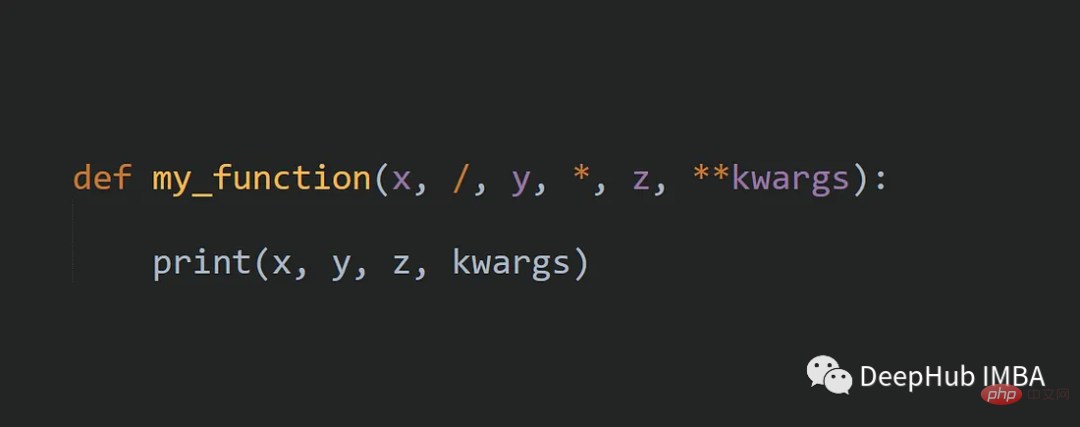本文將討論Python的函數參數。我們將了解args和**kwargs,/和的都是什麼,雖然這個問題是一個基本的python問題,但是在我們寫程式碼時會經常遇到,例如timm中就大量使用了這樣的參數傳遞方式。

許多人交替使用這些術語,但它們是有區別的:

def the_func(greeting, thing):
print(greeting + ' ' + thing)
the_func('hello', thing='world')the_func('hello', 'world')# -> 'hello world'
the_func('world', 'hello')# -> 'world hello'
the_func(greeting='hello', thing='world') # -> 'hello world'
the_func(thing='world', greeting='hello') # -> 'hello world'
the_func('hello', thing='world')# -> 'hello world'函數參數
我們將示範6個函數參數傳遞的方法,這些方法能夠覆寫到所有的問題。 1、如何取得所有未捕獲的位置參數使用*args,讓它接收一個不指定數量的形參。def multiply(a, b, args): result = a * b for arg in args: result = result * arg return result
在這個函數中,我們通常定義前兩個參數(a和b)。然後使用
args將所有剩餘參數打包到一個元組中。可以把*看作是獲取到了其他沒有處理的參數,並將它們收集到一個名為“args”的元組變數中:multiply(1, 2)# returns 2 multiply(1, 2, 3, 4)# returns 24
def introduce(firstname, lastname, **kwargs):
introduction = f"I am {firstname} {lastname}"
for key, value in kwargs.items():
introduction += f" my {key} is {value} "
return introductionprint(introduce(firstname='mike', lastname='huls')) # returns "I am mike huls" print(introduce(firstname='mike', lastname='huls', age=33, website='mikehuls.com')) # I am mike huls my age is 33 my website is overfit.cn
def transfer_money(*, from_account:str, to_account:str, amount:int):
print(f'Transfering ${amount} FORM {from_account} to {to_account}')
transfer_money(from_account='1234', to_account='6578', amount=9999)
# won't work: TypeError: transfer_money() takes 0 positional arguments but 1 positional argument (and 2 keyword-only arguments) were given
transfer_money('1234', to_account='6578', amount=9999)
# won't work: TypeError: transfer_money() takes 0 positional arguments but 3 were given
transfer_money('1234', '6578', 9999)下面是一個只允許位置參數的函數範例:
def the_func(arg1:str, arg2:str, /):
print(f'provided {arg1=}, {arg2=}')
# These work:
the_func('num1', 'num2')
the_func('num2', 'num1')
# won't work: TypeError: the_func() got some positional-only arguments passed as keyword arguments: 'arg1, arg2'
the_func(arg1='num1', arg2='num2')
# won't work: TypeError: the_func() got some positional-only arguments passed as keyword arguments: 'arg2'
the_func('num1', arg2='num2')def exceeds_100_bytes(x, /) -> bool:
return x.__sizeof__() > 100
exceeds_100_bytes('a')
exceeds_100_bytes({'a'})def len_new(x, /, *, no_duplicates=False): if (no_duplicates): return len(list(set([a for a in x]))) return len(x)
想計算變數x的len,只能按位置傳遞x形參的參數,因為它前面有一個/。 no_duplicate參數必須與關鍵字一起傳遞,因為它跟在
後面。讓我們看看這個函數都可以怎麼呼叫:print(len_new('aabbcc'))# returns 6
print(len_new('aabbcc', no_duplicates=True))# returns 3
print(len_new([1, 1, 2, 2, 3, 3], no_duplicates=False)) # returns 6
print(len_new([1, 1, 2, 2, 3, 3], no_duplicates=True))# returns 3
# Won't work: TypeError: len_() got some positional-only arguments passed as keyword arguments: 'x'
print(len_new(x=[1, 1, 2, 2, 3, 3]))
# Won't work: TypeError: len_new() takes 1 positional argument but 2 were given
print(len_new([1, 1, 2, 2, 3, 3], True)) def the_func(pos_only1, pos_only2, /, pos_or_kw1, pos_or_kw2, *, kw1, kw2, **extra_kw):
# cannot be passed kwarg <-- | --> can be passed 2 ways | --> can only be passed by kwarg
print(f"{pos_only1=}, {pos_only2=}, {pos_or_kw1=}, {pos_or_kw2=}, {kw1=}, {kw2=}, {extra_kw=}")# works (pos_or_kw1 & pow_or_k2 can be passed positionally and by kwarg)
pos_only1='pos1', pos_only2='pos2', pos_or_kw1='pk1', pos_or_kw2='pk2', kw1='kw1', kw2='kw2', extra_kw={}
pos_only1='pos1', pos_only2='pos2', pos_or_kw1='pk1', pos_or_kw2='pk2', kw1='kw1', kw2='kw2', extra_kw={}
pos_only1='pos1', pos_only2='pos2', pos_or_kw1='pk1', pos_or_kw2='pk2', kw1='kw1', kw2='kw2', extra_kw={'kw_extra1': 'extra_kw1'}
# doesnt work, (pos1 and pos2 cannot be passed with kwarg)
# the_func(pos_only1='pos1', pos_only2='pos2', pos_or_kw1='pk1', pos_or_kw2='pk2', kw1='kw1', kw2='kw2')
# doesnt work, (kw1 and kw2 cannot be passed positionally)
# the_func('pos1', 'pos2', 'pk1', 'pk2', 'kw1', 'kw2')def func(x,/,y,,z,**k):
(x,/,y,,z,**k):是函数的参数。总共有四个参数:
这样解释是不是就很明白了。
我们今天介绍的这个例子虽然在看源代码时没有遇到这么复杂的情况,但是在 面试 的时候还真有人问(虽然我觉得没啥用),所以最好还是知道一些,以免尴尬。
如果你忘记了,这里可以教你一个变通的办法,可以使用类似的回答:
上面的参数传递在开发时并不常用,因为对于开发规范来说,应该保证代码的可读性,我们这边遵循的开发规范是:
1、尽量不要在函数定义中将可变位置参数 *args 和可变关键字参数 **kwargs 放在一起,因为这样会让函数的调用方式变得不太直观。
2、在使用可变参数时,要保证函数的行为是可预测的。上面函数中的进行了太多的python语法糖,对于理解该函数的参数会造成很大的困惑,也就是可读性太差,我们在进行codereview(如果你了解什么是codereview就说,不了解就说组长检查)/组长merge代码 时会直接要求返工,所以我们在实际开发时是不会用这个的。
对于我阅读的开源代码,也都基本上使用的是 **kwargs这种情况(这里可以举两个例子),还没有看到有人写这么乱的代码,我想要是写这样的代码估计开源的人也会被人吐糟(这里自己可以自行延伸),所以这些参数传递的规则我在学习的时候看到过,但是实际中没见过真正使用,就不太记住了。
回到本文,我们介绍了设计函数参数的所有方法,并了解了如何混合和匹配它们,虽然后面几个内容可能你一辈子也不会用到,但是了解一下也是好的,因为万一呢。
以上是Python中函式參數傳遞方法*args, **kwargs,還有其他的詳細內容。更多資訊請關注PHP中文網其他相關文章!




